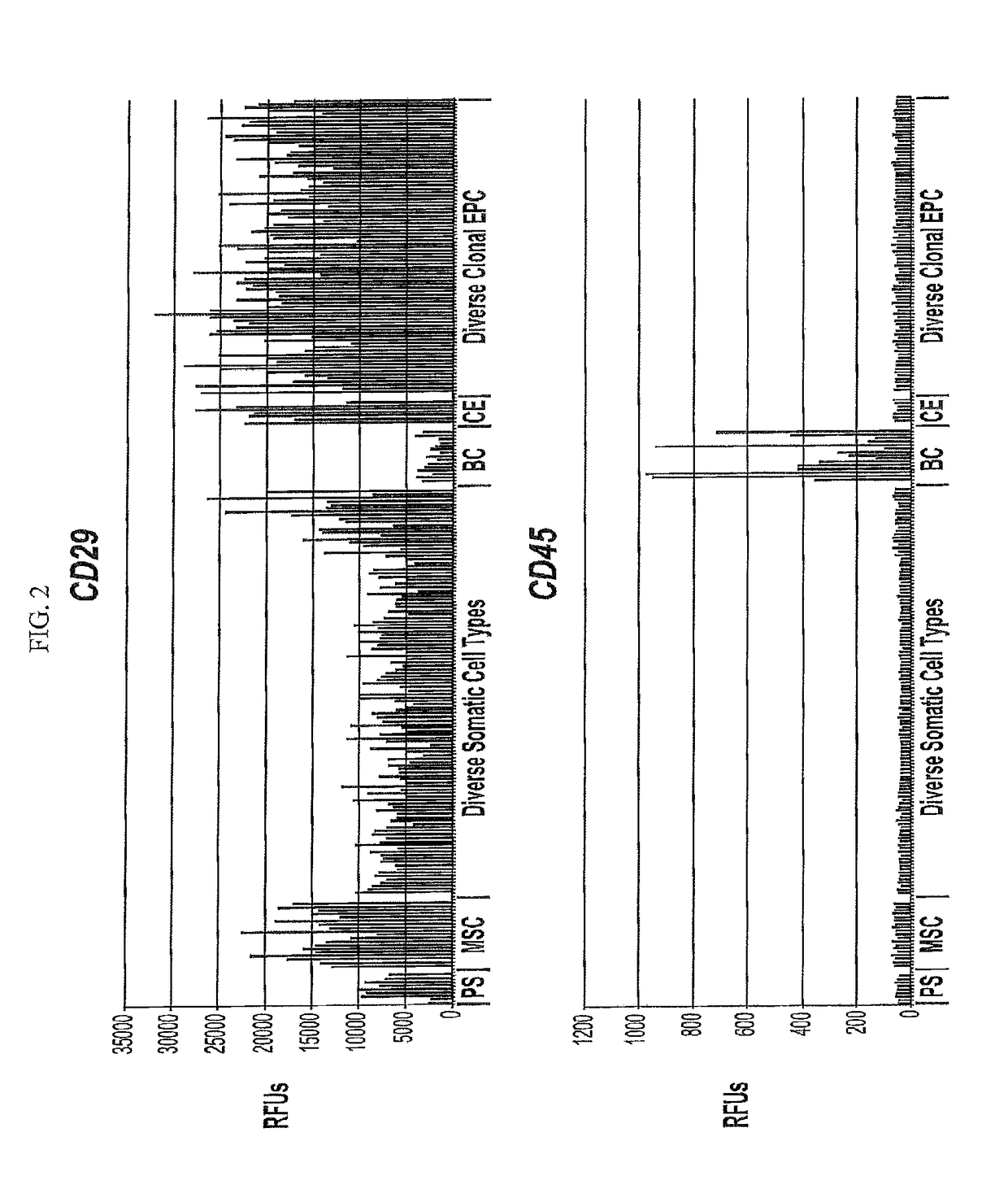Differentiated progeny of clonal progenitor cell lines
a technology of differentiated progenitor cells and stem cells, applied in the field of stem cell biology, can solve the problems of largely missing rigorous clonal data demonstrating differentiation beyond hypertrophic chondrocytes, osteoblasts, adipocytes, fibroblasts,
- Summary
- Abstract
- Description
- Claims
- Application Information
AI Technical Summary
Benefits of technology
Problems solved by technology
Method used
Image
Examples
example 1
Analysis of Chondrogenic hEP Cell Lines Under Differentiating Culture Conditions
[0281]Cell Lines and Growth Factors
[0282]The derivation of the hEP cell lines 4D20.8 (cat. #SCR220, Millipore Corporation, Temecula, Calif., USA; cat. #ES-84, BioTime, Alameda, Calif., USA), 7PEND24 (cat. #SCC122, Millipore Corporation; cat. #ES-283, BioTime), 7SMOO32 (cat. #ES-278, BioTime), E15 (cat. #ES-98, BioTime), MEL2 (cat. #ES-268, BioTime), SK11 (cat. #ES-250, BioTime), and SM30 (cat. #ES-256, BioTime) used in this study was previously described19. The hEP cell lines were routinely cultured in corresponding ESpan medium as recommended by manufacturer (BioTime, Alameda, Calif., USA). Mesenchymal stem cells were (Lonza, Basel, Switzerland) and were propagated in growth medium (cat. #C-28010; PromoCell, Heidelberg, Germany) with pen:strep (100 U / ml:100 ug / ml). The cells lines were maintained in and all subsequent experiments were carried out at 37° C. in an atmosphere of 10% CO2 and 5% O2 on gelati...
example 2
Discovery of Novel Clonal Human Embryonic Progenitor Cell Lines Capable of Cartilage and Tendon Differentiation when Differentiated in the Presence of TGFβ3 Together with: BMP2, BMP4, BMP6, BMP7, or GDF5
[0329]Additional clonal human embryonic progenitor cell lines previously disclosed (See U.S. patent application Ser. Nos. 12 / 504,630; 13 / 456,400) and incorporated by reference that did not show COL2A1 expression when differentiated in micromass conditions in the presence of 10 ng / mL of TGFβ3 alone, were differentiated for either 14 days in micromass conditions with combinations of 10 ng / mL of TGFβ3 together with one of the following other members of the TFG beta family: BMP2 (50 ng / mL), BMP4 (10 ng / mL), BMP6 (30 ng / mL), and BMP7 (100 ng / mL), and GDF5 (100 ng / mL) or alternatively, the cells were differentiated for 14 or 21 days in the presence of HYSTEM®-C (BioTime, Inc Alameda, Calif.) hydrogel as described herein supplemented with combinations of 10 ng / mL of TGFβ3 together with one ...
example 3
Osteochondral Potential of Clonal Human Embryonic Progenitor Cell Lines when Differentiated in HYSTEM®-C in the Presence of BMP4 and TGFβ3
[0331]Additional clonal human embryonic progenitor cell lines previously disclosed (See U.S. patent application Ser. Nos. 12 / 504,630; 13 / 456,400 incorporated by reference) were differentiated for either 14 or 21 days in the presence of HyStem-C (BioTime, Inc Alameda, Calif.) hydrogel as described herein supplemented with combinations of the TGF beta family
[0332]The cell line EN8 at passage 13 displayed the gene expression markers at 13-21 doublings of clonal expansion: CST1 (accession number NM_001898.2), FOXF1 (NM_001451.2), NEFM (accession number NM_005382.1), and ZIC2 (accession number NM_007129.2) and distal HOX genes expressed being HOXA2 and HOXB2, and unlike the cell lines EN7 and EN47, the line EN8 expressed low or undetectable RGS1 and did not express TH (tyrosine hydroxylase, accession number NM_199293.2, Illumina probe ID 1990068). As s...
PUM
 Login to View More
Login to View More Abstract
Description
Claims
Application Information
 Login to View More
Login to View More - R&D
- Intellectual Property
- Life Sciences
- Materials
- Tech Scout
- Unparalleled Data Quality
- Higher Quality Content
- 60% Fewer Hallucinations
Browse by: Latest US Patents, China's latest patents, Technical Efficacy Thesaurus, Application Domain, Technology Topic, Popular Technical Reports.
© 2025 PatSnap. All rights reserved.Legal|Privacy policy|Modern Slavery Act Transparency Statement|Sitemap|About US| Contact US: help@patsnap.com



